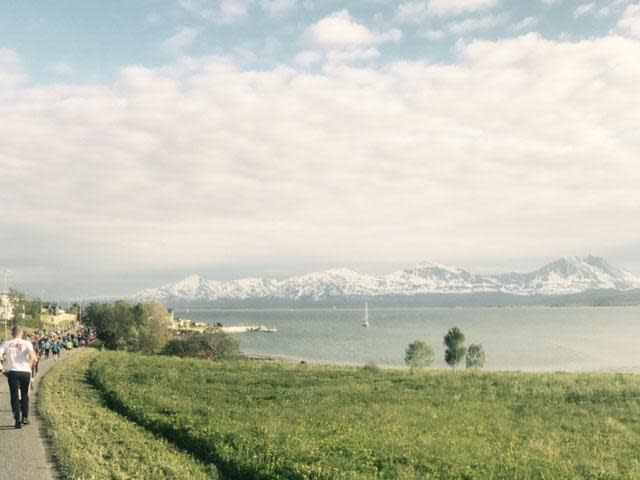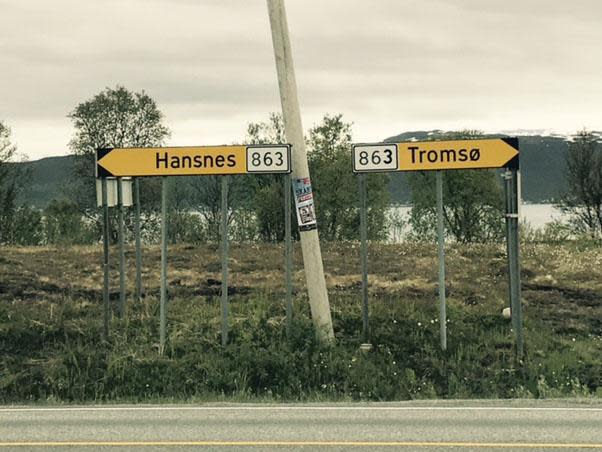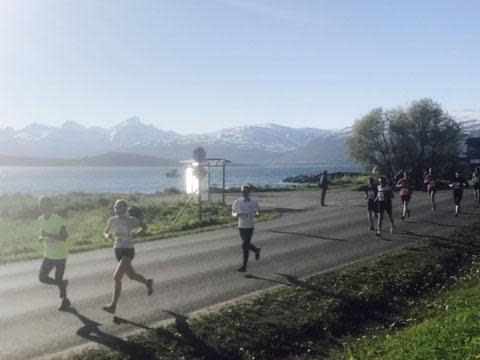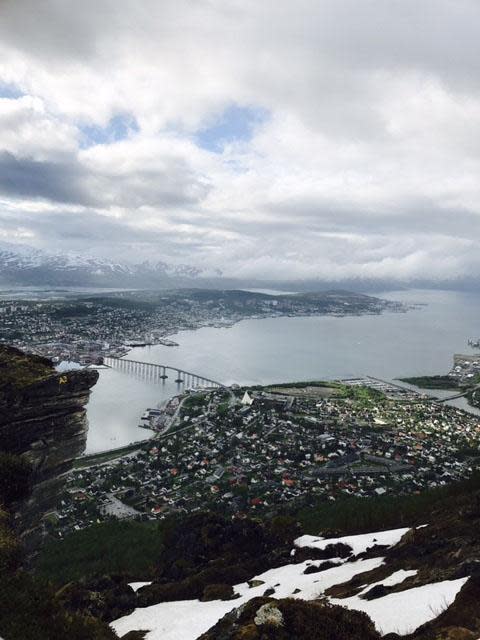Arctic running under the midnight sun is bigger than any trainer's ego

A few years ago, while I was training for a marathon, a friend snidely theorised that if runners were forced to take an oath of confidentiality, no one would ever voluntarily endure the gruelling ordeal of training for such events. It was a thinly veiled – not to mention rude – attempt at shutting me up. But I actually agree. Especially when it comes to charity runs, which we convince ourselves are wholly altruistic pursuits, there's often deep vanity involved. Talk of training tactics, refuelling rituals, routes and recovery can quickly become intolerably braggy— especially for poor bystanders who would only run if being chased. The physical benefits of running become an insignificant sideshow when pitted against what running does for our egos.
After a weekend in Tromso, though, I’ve changed my mind. I've realised that even if discussing the Midnight Sun Run were a sure fire way of ending up in the gallows, hundreds of hobby and not-so-hobby athletes from all over the world would still flock to northern Norway every midsummer. Complete discretion would seem a trivial price to pay for taking part in this unique celebration of rugged nature and team spirit, not to mention for bearing witness to the most baffling peculiarities astronomy can offer.
More than 200 miles north of the arctic circle, Tromso is primarily known as a destination for globetrotters eager to get a glimpse of the Northern lights, but during the summer months, when the sun never sets, the fjords and surrounding mountains are almost constantly bathed in a misty glow, transforming the area into a luscious haven for anyone with even the remotest penchant for nature.
The city itself is not beautiful. A harbour forms the centrepiece. It’s dotted with restaurants, bars, cafes and a few shops that sell select tourist tat, but it's down-to-earth and functional, sporting far fewer clichéd tourist traps than other Scandinavian destinations. When you walk into a shop or restaurant, you tend to be greeted first in Norwegian and assumed to be a local, or at least a fellow countryman – even on what is easily one of the busiest weekends of the year for visitors from abroad.

On the one hand, it’s endearing. It gives you the impression that you really are exploring a community and not just chipping away at the superficial veneer of a culture. On the other hand, it's a little gloomy. It's a reminder of just how isolated and otherworldly Tromso is: plunged in near darkness for almost six months of the year (the Morketiden, or “murky times”, as they call it) depression is much more prevalent than in southern Europe. The glum and often twisted works of playwright Henrik Ibsen spring to mind. Edvard Munch’s harrowing The Scream, which I’d seen in Oslo a few days earlier, a masterpiece that’s thought to depict the anxious disposition of modern man. I can imagine what might have inspired Mr Munch to put his paintbrush to work.
Around the clock sunshine might seem like a delightful prospect in the depths of black-out December and January, but that too seems to have its downsides. It's hard to sleep when day glides into night and back again seamlessly. When I left after three days, I felt oddly sleep-deprived and a little confused; a bit hungover, even though I’d avoided those lethal northern spirits.

Tromso is the third most populous city north of the Arctic Circle but the whole municipality still only has a population of just over 70,000 - or about half the size of Cambridge. Beyond the immediate centre, it's mostly residential with people emanating self-sufficiency and a no-nonsense approach to living. There’s no big tourist hub or shopping mall. In fact, from one of the mountains overlooking the city – reached by cable car or muddy trek for the brave – the most striking thing that you will see is an eclectic patchwork of modern and traditional architecture. Rust red traditional wooden houses are interspersed with obscure modern constructs, severe shapes and angles of steel and glass. It’s as if the city were the cutting floor of a super-sized episode of Grand Designs, all set against an arresting backdrop of snow-covered peaks, even at the height of the arctic summer.
***
As an avid runner, a lover of the outdoors and someone who jumps at an excuse to escape London's temperamental summer weather, the Midnight Sun Marathon has been on my bucket list for years. I'd initially intended to tackle the full 26 miles but my hip and knee had other plans and after taking a tumble and twisting my knee badly while training in May, I transferred my registration to the 10-kilometre category.
It's often said that for a fiercely stubborn runner – and let’s face it, many of us are – the pain of pulling out of a race is less tolerable than forfeiting a spot completely. So having paid for flights, an Airbnb that wasn't cheap, as well as covering all the costs associated with a one-day pitstop in the capital - I wasn't about to let this one pass me by.
Slightly nervous, adrenaline-fuelled and armed with a heavy-duty knee bandage, I therefore joined my fellow runners for the 7pm starting gun on 17 June - the longest day of the year - and prayed to the running gods that my joints would forgive me for the pounding I was about to inflict upon them.

If I've already piqued your interest and you fancy giving this one a go, take my advice and don't be fooled by Tromso’s arctic coordinates.
When I landed that morning at the tiny domestic airport a seven-minute drive from the city centre, it was distinctly chillier than it had been in Oslo, but due to the warming effect of the Gulf Stream, the weather in Tromso is often much milder than in places on a similar latitude.
As we made our way north out of the city and swerved down to the road that traces the water front, it wasn't long before I wished I'd opted for lighter gear.
The sun still stood high in the sky, beating down on the entrancingly calm Norwegian Sea. In their shorts and vest tops, it wasn't hard to pick the locals out of the fast-paced field. It might've initially felt like a mild winter's day to me, but this was the height of summer for them, and they were probably being spurred by the thought of a cold beer and barbecue on the terrace post-cool down.
I've taken part in dozens of organised road races – strikingly scenic ones too – and I'm usually averse to routes that double back on themselves, aware of just how quickly I get bored, but this one masters the challenge with aplomb.
Just over a mile in, the gently undulating road gives way to the sweeping vista of an azure sea, set against a string of mountains so striking I couldn't help myself from doing two things I never do. Firstly, mid-race, with the clock ticking and dozens of gazelle-like Scandinavians hustling by, I stopped to take a photograph. And secondly, I got a little emotional. When you find yourself in a place that really does feel like the end of the world, you can’t help but reflect on how vast, striking and rich our planet is, and how irrelevant and fleeting our existence.

The rest of the race passed in somewhat of a blur. The sunshine showed as much staying power as the crowds of ruddy-cheeked locals cheering from the sidelines, many brandishing cowbells and whistles. The views didn't grow old and neither did the camaraderie among the runners, despite a palpable sense of healthy competition.
In the end, after eight weeks of virtually no training at all, I crossed the finish line about five minutes faster than expected. Perhaps it was the breathtaking scenery that drove me, or the effect of the arctic air on someone accustomed to slogging through the London smog. Either way, I felt ecstatic, and amazed at how awe-inspiring something as mundane as running along a tarmac road can be.
Scandinavian efficiency dominated the finishing set up too: in addition to the customary water and energy drinks, volunteers distributed chopped bananas and punnets of blueberries. Hugs and kisses were exchanged and hands were shaken as the sun stayed pinned to the sky.
Later, hundreds more runners embarked on the half- and full-marathon distances while I traipsed off to one of a handful of fish restaurants dotted across the town.
At midnight, as we trundled home, the sky was still as bright as it would be on a British winter's noon. It wasn't quite the blood red spectacle that some of the sports nut Twitter feeds and websites had suggested, but I suppose that unpredictability is yet another thing that makes this type of raw, rugged nature so enchanting.
Prone to falling into a comatose sleep after runs like this, I struggled to sleep that night. Pathetically, I constructed a blackout curtain out of towels and spare blankets as the sun reversed its course and started inching higher in the sky again.
I replayed the race in my head over and over: the people, the sea, the mountains, the light, the fresh air. Perhaps next year I’ll manage the whole 26 miles. But you must admit, it would be a bit of a shame to have to sign that confidentiality oath.

 Yahoo News
Yahoo News 